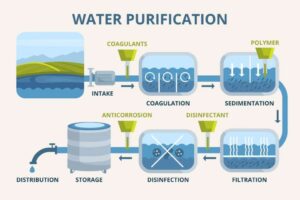Pollution Generated in the Kitchen
The kitchen is an important part of any household where food is cooked, meals are prepared and families come together to share a meal. However, the kitchen can also be a source of pollution. Cooking, cleaning, and even the food we eat can all contribute to different kinds of pollution in the kitchen. In this blog post, we will explore the various types of pollution in the kitchen and how to minimize their impact.
Types of Pollution and Unhealthy situations
- Air Pollution
- Water Pollution
- Waste or food pollution
- Noise pollution
Air Pollution
- Air pollution is a significant concern in the kitchen due to the presence of gas stoves, ovens, and other cooking appliances. Burning natural gas, propane, or other fuels during cooking can release harmful gases and particles into the air
- These pollutants can cause respiratory problems and aggravate existing conditions such as asthma or allergies. Carbon monoxide is one of the dangerous gases emitted during cooking, and its buildup in the kitchen can be fatal if not detected and addressed promptly
- To minimize air pollution in the kitchen, ensure proper ventilation by opening windows or using an exhaust fan during cooking. Regular cleaning of the oven and stove burners also helps to reduce the buildup of harmful particles.
- You can use a suitable air filter to control air pollution due to outside polluted air and dirty air due to the nearest roads. For this refer the post on this website

Water Pollution
- Water pollution in the kitchen is often caused by the use of detergents, soaps, and cleaning products that contain harmful chemicals. When these products are washed down the drain, they can contaminate water sources and harm aquatic life. Similarly, chemicals from pesticides and fertilizers used in growing crops can also contaminate water sources
- To minimize water pollution, use eco-friendly cleaning products that are free from harmful chemicals. Also, consider reducing the use of pesticides and fertilizers in growing your own food or choose organic options.
- You can select a suitable water purifier to control the hardness which is given in the previous post

Waste Pollution
- Waste pollution in the kitchen is mainly caused by food waste and packaging materials
- When food waste is disposed of improperly, it can emit methane gas, which contributes to global warming. Packaging materials such as plastics and styrofoam can also take years to decompose and harm the environment
- To minimize waste pollution in the kitchen, compost food scraps, and use biodegradable packaging materials. Also, consider using reusable containers for food storage instead of single-use plastics.

Types of waste in the home
There are several types of waste that can be found in a kitchen, including:
-
- Food waste: This includes any scraps or leftovers from cooking or meal preparation, such as vegetable peelings, fruit cores, eggshells, and spoiled or expired food.
- Packaging waste: This includes any packaging materials used for food products, such as plastic bags, food wrappers, cardboard boxes, and aluminum foil.
- Paper waste: This includes any paper products used in the kitchen, such as napkins, paper towels, and food packaging.
- Glass waste: This includes any glass products used in the kitchen, such as glass jars, bottles, and dishes.
- Plastic waste: This includes any plastic products used in the kitchen, such as plastic bags, food containers, and utensils.
- Hazardous waste: This includes any items that may be hazardous to human health or the environment, such as cleaning products, batteries, and light bulbs.
- By identifying the types of waste in the kitchen, we can take steps to reduce, reuse, and recycle these materials, thereby reducing our impact on the environment and contributing to a cleaner, healthier planet
- Types of wastage generated in the home shown in the figure
Noise Pollution
- Noise pollution in the kitchen can be caused by loud appliances such as blenders, mixers, and exhaust fans
- Prolonged exposure to noise pollution can cause hearing loss and other health problems
- To minimize noise pollution, choose appliances with low noise levels, and limit the use of noisy appliances during certain times of the day.
Summary
- In conclusion, the kitchen is an essential part of any household, but it can also be a source of pollution. By taking simple steps such as proper ventilation, using eco-friendly cleaning products, composting food waste, and choosing low-noise appliances, we can minimize the impact of pollution in the kitchen and protect our health and the environment
- To reduce food contamination, wash your hands before and after handling food, use separate cutting boards for meat and produce, store food at the proper temperature, and cook food to the correct temperature
- To reduce the impact of pollution in the kitchen, we can take steps such as using a range hood, avoiding pouring chemicals down the drain, using quieter appliances, and properly handling and storing food
- By taking these steps, we can create a safer and healthier environment in our homes.

